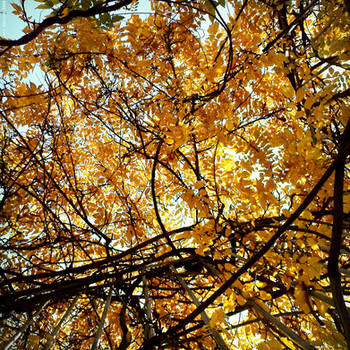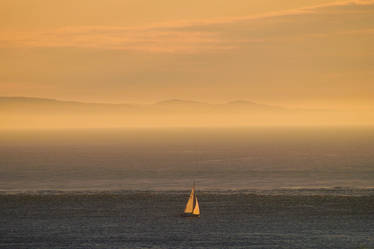For many Photographers, Autumn is now officially here and is one of the most exciting seasons to capture in terms of colour, change and vistas. Early morning mist, late afternoon sun, orange, red and golden hues - Autumn has a lot to offer in many countries. If you're like me, Autumn often arrives all at once and it can be tricky to know how to make the best of the season before it's over. A couple of days of high winds and rain can ruin the best Autumnal captures by ripping the leaves down before you've even got the chance to snap - so it's great to be prepared for the season.
Leading lines are particularly useful. Yet so many people quote ' Look for leading lines...' or 'You've captured the leading lines here perfectly' and really do we even know properly what they are? The purpose of a leading line is to draw a viewers eye into the photograph and then on a journey - through it. Think of it as a visual narrative. They can be intentional and indeed unintentional in captures. Where Autumn is concerned, photographers often wish to tell a story.
Bridges are the obvious choice for grabbing a shot that leads a viewer into the image. In Forests especially, Bridges are likely to be bordered either side by Autumn trees and, if you're lucky, up ahead too. This creates a lovely view especially if you have a vanishing point in the distance. But the other location that Photographers often forget to think of - especially in the UK - is motorway bridges.
Established roads that have had years of trees and forest growing up alongside them are perfect in Autumn, especially when you can get a high vantage point and look down the length of the road. These sorts of locations are especially awesome for grabbing leading lines in a shot. You can get creative too, crouch down, reach up, turn the camera and so on.
Don't forget to look UP. Sometimes, the best shots are the ones captured when you stop looking around at eye level and point your camera skywards to capture the Autumn trees above. Even better if you capture a crisp blue sky too. This is particularly useful in dense forests and woods, where the canopy is thick and inter-twining. It's unusual, it's not often captured and it's just different.
The best types of lens for this kind of shot are wide angle, or fish eye if you're lucky enough to have one. Portrait/macro lens can also work well depending on what focal length and angle you've got on them. Use the tree trunks to your advantage and look for linear patterns, symmetry and abstract shapes to enhance your shot.
In complete contrast, look down too. Forest floors are the favourite for capturing leafy orange carpets and other things such as Conkers and fir cones. But what about looking at a street floor too? Or shooting on the eye level of a bench surrounded by Autumn leaves? Those sorts of views are a bit different and again offer something unique, often. Shooting at the eye level of another person is also useful, a child in particularly. Crouching works well for different vantages, similarly laying your camera on the floor is also useful - careful though!
Your long lens also shouldn't be forgotten in Autumn. Focusing in on a single leaf with a spectacular orange background works really well. Additionally capturing Autumn leaves in sunlight creates a nice bokeh affect in the background which always works well. You can also use a macro lens to get close, but zooming in from afar works well too. If it's particularly blowy, use a tripod or stabilise your body as best as you can to avoid too much blur. However...sometimes a blurry leaf can look awesome too!
Don't always rely on colour. You can up the saturation of an image after you've taken it if you wish to. But you don't have to rely on the golds, reds and oranges of Autumn to make a beautiful image. Particularly where there is mist - there is the opportunity to capture some fantastic shots in monochrome. Don't forget about black and white, and don't be disappointed if your Autumns are not as vibrant as you want them to be - you can make the best of bad weather!
There are other tools which can help you capture Autumn in the best way possible. One of these is a Graduated Neutral Density Filter. They help particularly with controlling light. If you've got too much bright sky they are really useful but they also help to balance light in other situations too. Lens hoods are great to avoid sun flare, unless you want those captured - which some people do in the right circumstances! Also don't forget your tripod - you never know what opportunities might present themselves.
ShopDreamUp AI ArtDreamUp
Nom Nom #90 It's Christmas!!!!!
Merry CHRISTMAS! In honour of the festive day, this month's Nom Nom theme is focusing on tasty seasonal noms of the very best kind! Whether you celebrate the season or not, these tasty treats are bound to have you licking your lips and breaking out the baking utensils!
Previous Noms
Strawberries | Cinnamon | Chicken | Apples | Chocolate | Brussel Sprouts | Cocktails | Ice Cream | Spaghetti | Raspberries | Pineapple | Bread | Rice | Blueberries | Cupcakes | Tea | Cherries | Toast | Cheesecake | Soup | Apple Pie | Casserole | Halloween | Sausage | Pie | Macaroons | Sushi | Christmas | Peppers | Chinese Food | Eggs | Ham | Garlic | Tomatoe |
Sometimes when you're not looking...
The best things pop up in your newsfeed. And oh my gosh I've been getting to know my newsfeed again today. Things actually appear in there. I'm ashamed to say that when I was a CV a lot of the time it became a click and delete activity, because there was so much. I lost touch with people, I lost touch with a lot of what I wanted to do and what I was interested in. So with this in mind, I found Farand (https://www.deviantart.com/farand)'s latest journal really poignant as he shared this quote...
"The important point for us is to realise that we are basically good. Our only problem is that sometimes we don't actually acknowledge that goodness. We don't see it, so we blame
Nom Nom 89#
This time around, the Tasty Nom has been suggested by cookielover17 (https://www.deviantart.com/cookielover17) who suggested that I put together a feature of Childhood Nostalgia images. It's hard to do because we've all likely had so many different memories across the world, but here are just a few I found when I searched! What are your favourite childhood treats and recipes?
Previous Noms
Strawberries | Cinnamon | Chicken | Apples | Chocolate | Brussel Sprouts | Cocktails | Ice Cream | Spaghetti | Raspberries | Pineapple | Bread | Rice | Blueberries | Cupcakes | Tea | Cherries | Toast | Cheesecake | Soup | Apple Pie | Casserole | Halloween | Sausage | Pie | Macaroons | Sush
This is where I leave you
I just love dramatic titles. I'm not leaving you though, but yes today is the day that things change after such a long time.
I started my Volunteer career on DeviantArt in July 2010. So that means I've been floating around your inboxes, DDing, writing articles and doing lots of photography related shenanigans for over half a decade. Of course, I started out long before that but offically and all that, it's been over five years.
Half a decade. A Demi-Decade. Five years. I have to say that it has flown by. From the day that I first pestered moonbeam13 (https://www.deviantart.com/moonbeam13) into letting me oversee a gallery that technically wasn't vacant (Abstract and Surreal
Featured in Groups
© 2012 - 2024 Kaz-D
Comments32
Join the community to add your comment. Already a deviant? Log In
This is a great article with some nice images included that are both beautiful and instructive. Yay for autumn! 










